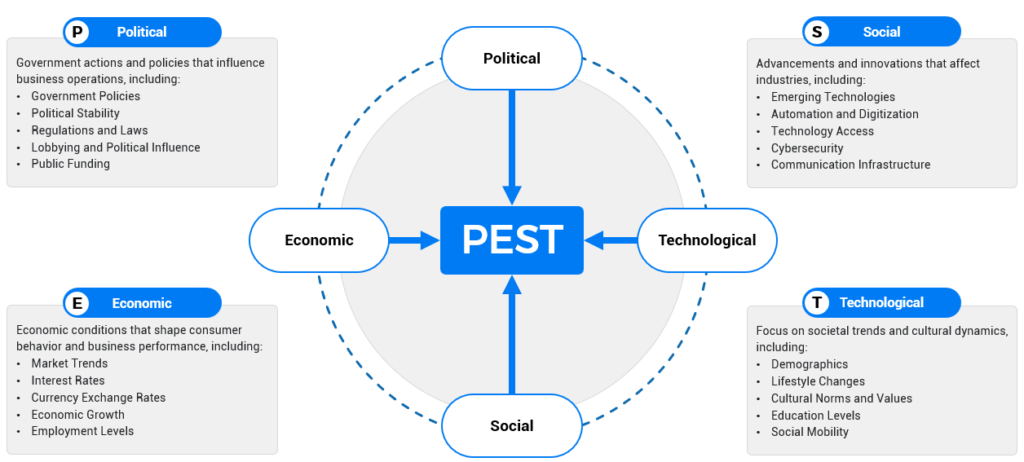Introduction to PEST Analysis
PEST Analysis is a strategic tool used by businesses to analyze the external environment they operate in. It helps organizations identify factors that could impact their performance.
The concept was first introduced by Francis Aguilar in 1967 in his book Scanning the Business Environment. Over time, it has become a staple in strategic planning and decision-making across industries.
The term PEST stands for Political, Economic, Social, and Technological factors.
The Core Idea Behind PEST Analysis
PEST Analysis helps businesses scan the external environment to uncover opportunities and threats. It provides a structured approach to understanding how macro-environmental forces affect a company’s growth, stability, and adaptability.
Think of it as a wide-angle lens for examining the bigger picture—factors that are often beyond a company’s direct control but essential to plan for.
Breaking Down the PEST Factors
Political Influences
These involve government actions and policies that influence business operations. A change in regulations can open doors to new markets or create barriers to entry.
Aspects to consider:
- Government Policies: Taxation, trade tariffs, subsidies, or industry-specific regulations.
- Political Stability: How stable is the government? Are there risks of political upheaval or changes in power?
- Regulations and Laws: Employment laws, environmental laws, and consumer protection regulations.
- Trade Agreements: International trade treaties or restrictions (e.g., free trade zones, embargoes).
- Lobbying and Political Influence: Potential for influence by political groups or industry lobbyists.
- Public Funding: Availability of grants or incentives for specific industries.
Example prompt: Please list important policy/regulatory events that have affected [an industry] in the past 1 year and the structural changes it has brought about.
Economic Conditions
These address the economic conditions that shape consumer behavior and business performance. Economic trends often dictate purchasing power and market demand.
Aspects to consider:
- Market Trends: Inflation, deflation, or economic recession.
- Interest Rates: Impact on borrowing costs for businesses and consumers.
- Currency Exchange Rates: Especially relevant for international trade.
- Economic Growth: Trends in GDP growth and sector-specific growth rates.
- Employment Levels: Labor availability, wages, and skill gaps in the workforce.
- Consumer Spending Power: Disposable income levels and savings rates.
Example prompt: Please briefly describe the macro drivers of [an industry] in light of current consumer confidence, financing trends, and cost structure changes.
Social Trends
These focus on societal trends and cultural dynamics. Social shifts can redefine market preferences, such as growing demand for sustainable products.
Aspects to consider:
- Demographics: Age distribution, population growth, gender ratios, and ethnic diversity.
- Lifestyle Changes: Shifting preferences such as work-life balance, health consciousness, or eco-conscious living.
- Cultural Norms and Values: How traditions or attitudes influence purchasing behavior.
- Education Levels: Impact on workforce skills and consumer awareness.
- Social Mobility: Opportunities for upward mobility within society.
- Health Awareness: Trends in wellness, nutrition, and public health concerns.
Example prompt: Please analyze the current consumption perception and emotional value preference of the main population in [an industry].
Technological Advancements
These relate to advancements and innovations that affect industries. Staying ahead of technological trends can give businesses a competitive edge or mitigate obsolescence.
Aspects to consider:
- Emerging Technologies: AI, blockchain, IoT, and other disruptive technologies.
- Automation and Digitization: Adoption of robotics, machine learning, or other tools to enhance productivity.
- Research and Development (R&D): Innovation trends within your sector.
- Technology Access: Availability and affordability of technology for consumers and businesses.
- Cybersecurity: Risks and investments to protect data and systems.
- Communication Infrastructure: Internet penetration, mobile technology, and connectivity speeds.
- E-commerce Growth: Changes in how consumers shop online.
Example prompt: Please list 3 core technologies that are impacting [an industry] and describe the business opportunities they present.
Unlock all frameworks and templates
Unlock exclusive thinking frameworks and practice templates.
Become a member to access all premium content to elevate your thinking!
PEST Analysis simplifies strategic planning by highlighting the key drivers of change in the external environment. Whether you’re launching a product, entering a new market, or developing a long-term business strategy, this framework helps you navigate uncertainties and stay ahead.
Template
Get into the real practice now.

Available in the Templates
Go to Templates to download the resource.


